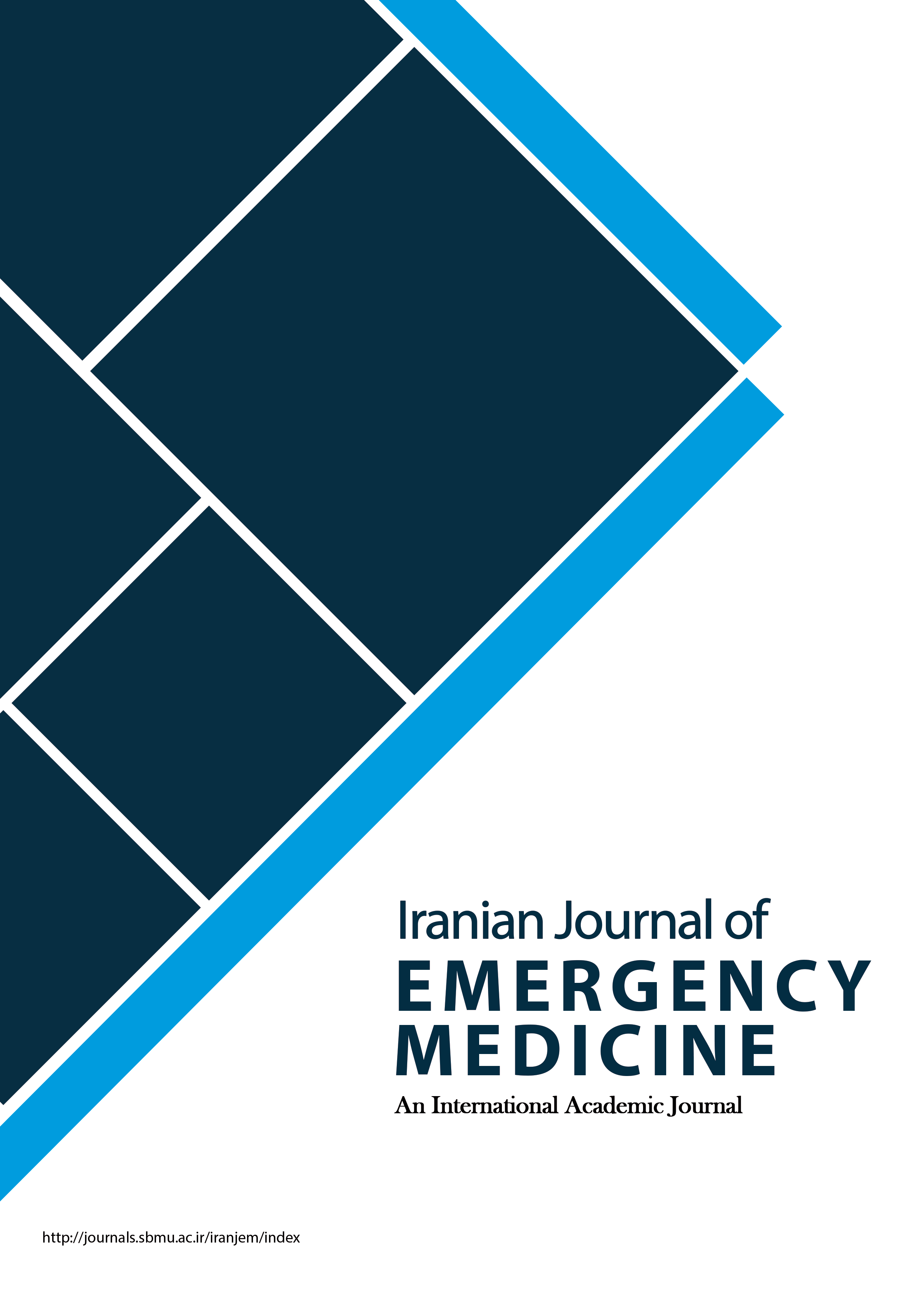Decision-Making for Patients Referring to Emergency Department Before and After the Establishment of Emergency Medicine; a Comparative Study
Iranian Journal of Emergency Medicine,
Vol. 8 No. 1 (2021),
23 November 2020
,
Page e3
https://doi.org/10.22037/ijem.v8i1.32490
Abstract
Introduction: The need for the training of emergency physicians was felt in the mid-20th century in response to rising public expectations for access to quality and specialized medical care around the clock. This study was conducted with the aim of comparing the decision-making status of patients referring to Imam Reza Hospital’s Emergency Department in Birjand before and after the establishment of emergency medicine.
Methods: In this comparative study, 800 patients who were admitted to the emergency department of Imam Reza Hospital, Birjand, Iran, from March to September in 2011 (before the establishment of emergency medicine) and 2017 (after the establishment of emergency medicine) were compared regarding the status of decision-making. Patient information (including patient demographics, reason for referral, length of hospital stay, and time to assignment, discharge or referral) was collected from a paper file or the hospital information system (HIS). After collecting the data, they were entered in SPSS software version 16 and Mann-Whitney and Chi-square tests were used at a significance level of 0.05.
Results: Mean time to decision-making had reduced from 343.1 ± 222.73 minutes to 200.19 ± 174.33 minutes after the deployment of emergency medicine specialists (P<0.001). There was a significant difference between the frequency of discharge against medical advice, and decision-making regarding the patients in less than 6 hours and 12 hours between the two time periods (P<0.05). The number of patients who were referred to other medical centers and other wards was not significantly different between the two time periods (P>0.05).
Conclusion: The presence of emergency medicine specialists, as a successful model in the health system, led to an increase in speed, quality, and accuracy of providing services to patients admitted to the emergency department.
- Emergency Medicine; Emergencies; Clinical Decision-Making; Birjand
How to Cite
References
Rahmani H, Arab M, Akbari F, Zeraati H. Structure, process and performance of the emergency unit of teaching hospitals of Tehran University of Medical Sciences. Journal of School of Public Health and Institute of Public Health Research. 2006;4(4):13-22. [Persian]
Zohour A, Pilevarzade M. The study of service provision speed in emergency department of Kerman Bahonar hospital in 2000. Journal of Iran University of Medical Sciences. 2004;35:413-20. [Persian]
Brilli RJ, Spevetz A, Branson RD, Campbell GM, Cohen H, Dasta JF, et al. Critical care delivery in the intensive care unit: defining clinical roles and the best practice model. Critical care medicine. 2001;29(10):2007-19.
Rivers EP, Nguyen HB, Huang DT, Donnino MW. Critical care and emergency medicine. Current opinion in critical care. 2002;8(6):600-6.
Cowan RM, Trzeciak S. Clinical review: emergency department overcrowding and the potential impact on the critically ill. Critical care. 2004;9(3):1-5.
Chardoli M, Mayel M, Mofidi M, Rezai M. Assessment of Emergency Department with Emergency Medicine Specialists regard to Ministry of Health standards in Tehran. Journal of Medical Council of Iran. 2012;29(4):338-46.
Judkins S. Paediatric emergency department design: Does it affect staff, patient and community satisfaction? Emergency medicine. 2003;15(1):63-7.
Zink BJ. Anyone, anything, anytime: a history of emergency medicine: Elsevier Health Sciences; 2005.
Suter RE. Emergency medicine in the United States: a systemic review. World journal of emergency medicine. 2012;3(1):5.
Buesching DP, Jablonowski A, Vesta E, Dilts W, Runge C, Lund J, et al. Inappropriate emergency department visits. Annals of emergency medicine. 1985;14(7):672-6.
Hsia RY, Nath JB, Baker LC. California emergency department visit rates for medical conditions increased while visit rates for injuries fell, 2005–11. Health Affairs. 2015;34(4):621-6.
Trauma NRCCo, Shock NRCCo. Accidental death and disability: the neglected disease of modern society: US Department of Health, Education and Welfare, Health Services and Mental …; 1970.
Bidari A, Hatamabadi HR. Emergency Medicine; a Review of the Past and a Look to the Future. Iranian Journal of Emergency medicine. 2016;3(1):1-3. [Persian]
Shojaee M, Kariman H, Hatamabadi HR, Sabzghabaie A, Dolatabadi AA, Moghadam MA, et al. History and guideline of emergency medicine residency discipline in Shahid Beheshti University of Medical Sciences, Iran; review of 2014. Iranian Journal of Emergency Medicine. 2014;1(1):2-10.. [Persian]
Mohtasham Amiri Z, Haghdoost Z, Mohseni M, Asadi P, Kazemnezhad Leili E. Patients discharged before and after presence of medical emergency specialists. Journal of Holistic Nursing And Midwifery. 2014;24(1):64-70.. [Persian]
Grossman MD. The role of emergency medicine physicians in trauma care in North America: evolution of a specialty. Scandinavian Journal of Trauma, Resuscitation and Emergency Medicine. 2009;17(1):1-6.
Asadi P, Kasmaie VM, Zohrevandi B, Ziabari SMZ, Marzbani B. Disposition of patients before and after establishment of emergency medicine specialists. Iran J Emerg Med. 2014;1(1):28-33.. [Persian]
Hashemi B, Baratloo A, Rahmati F, Forouzanfar MM, Motamedi M, Safari S. Emergency department performance indexes before and after establishment of emergency medicine. Emergency. 2013;1(1):20-3. [Persian]
- Abstract Viewed: 292 times
- pdf (فارسی) Downloaded: 176 times



